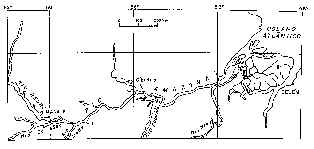Mark Harris
Brazilian Case Study Introduction
 This case study focuses on the people who live on the floodplains of the River Amazon. In particular it addresses the constitution of their historical and contemporary identities. This means looking at these identities through the double perspective of cultural reproduction and historical transformations. On one side there is their own work of creating an identity and on the other lies the processes which integrate them in larger scheme of things. As is clear from the other material by John Gledhill, anthropologists need to study the interaction of these forces, the social space and time in which they configure and reconfigure.
This case study focuses on the people who live on the floodplains of the River Amazon. In particular it addresses the constitution of their historical and contemporary identities. This means looking at these identities through the double perspective of cultural reproduction and historical transformations. On one side there is their own work of creating an identity and on the other lies the processes which integrate them in larger scheme of things. As is clear from the other material by John Gledhill, anthropologists need to study the interaction of these forces, the social space and time in which they configure and reconfigure.
In a sense I do not simply offer a portrait of a peasant group that follows conventional categories and understandings. I have tried to extend and innovate the ways in which ethnography can be presented. The current medium offers a particular challenging possibility for such an undertaking. Part of the success of this experiment depends however on the active participation of the viewer in constructing their own level of meaning. My method is more suggestive than explanatory. This is after all a teaching resource.
I have tried to keep the text down to a minimum (you can always read books for dense text), though in a few sections I have included so me longer discussions. For the most part, I have sought to use the photographs to lead the viewer through my narrative.
me longer discussions. For the most part, I have sought to use the photographs to lead the viewer through my narrative.
The Amazon floodplain varies in width along the river's course. It is estimated to cover about 0.2% of all the land in Amazonia. Up to the Rio Tapajós on the south bank tidal movement can be felt from the Atlantic Ocean.


 This case study focuses on the people who live on the floodplains of the River Amazon. In particular it addresses the constitution of their historical and contemporary identities. This means looking at these identities through the double perspective of cultural reproduction and historical transformations. On one side there is their own work of creating an identity and on the other lies the processes which integrate them in larger scheme of things. As is clear from the other material by John Gledhill, anthropologists need to study the interaction of these forces, the social space and time in which they configure and reconfigure.
This case study focuses on the people who live on the floodplains of the River Amazon. In particular it addresses the constitution of their historical and contemporary identities. This means looking at these identities through the double perspective of cultural reproduction and historical transformations. On one side there is their own work of creating an identity and on the other lies the processes which integrate them in larger scheme of things. As is clear from the other material by John Gledhill, anthropologists need to study the interaction of these forces, the social space and time in which they configure and reconfigure.  me longer discussions. For the most part, I have sought to use the photographs to lead the viewer through my narrative.
me longer discussions. For the most part, I have sought to use the photographs to lead the viewer through my narrative.